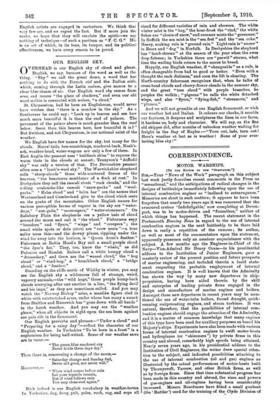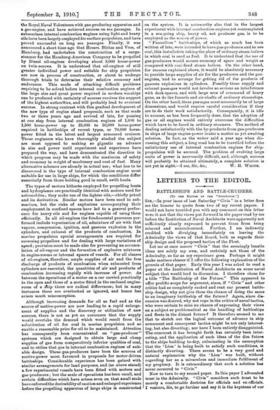CORRESPONDENCE.
MOTOR WARSHIPS.
[To raz Eorros Or TEM "SrEcrAroit."]
Sra,—Your "News of the Week" paragraph on this subject last week justly describes recent comments in the Press is "sensational," and the anticipations of radical changes in the designs of battleships immediately following upon the use of internal combustion engines as "inclined to extravagance." Memories are short in such matters; it appears to have been forgotten that nearly two years ago it was rumoured that the armoured cruiser 'Indefatigable,' now completing at Devon- port, was to be motor-driven and "funnelless," neither of which things has happened. The recent statement in the Portsmouth Evening News in regard to the use of internal combustion engines in the next battleship to be there laid down is really a repetition of the rumour ; its author, as well as most of the commentators upon the statement, apparently possesses only an amateur acquaintance with the subject. A few months ago the Engineer-in-Chief of the Navy—Vice-Admiral Sir Henry Oram—in his presidential address to the Institution of Junior Engineers, gave a masterly review of the present position and future prospects of marine engineering, and included therein a lucid state- ment respecting the probable employment of internal combustion engines. It is well known that the Admiralty has shown the way by many new departures in ship- propulsion, having been aided therein by the skill and enterprise of leading private firms engaged in the design and manufacture of marine engines and boilers. Amongst these new departures in recent years may be men- tioned the use of water-tube boilers, forced draught, quick. running reciprocating engines, and steam turbines. It was natural, therefore, that the possibilities of internal com- bustion engines should engage the attention of the Admiralty, and it is a matter of common knowledge that many engines of this type have been used for auxiliary purposes on board his Majesty's ships. Experiments have also been made with various forms of internal combustion engines in swift motor-boats and hydroplanes (or "skimmers ") by private firms in this country and abroad, remarkably high speeds being attained. Nearly seven years ago, in his presidential address to the Institution of Civil Engineers, the writer drew special atten- tion to the subject, and indicated possibilities attaching to the use of internal combustion (oil and gas) engines as illustrated by the actual performances of motor-boats built by Thornyeroft, Yarrow, and other British firma, as well as by foreign firms. Since that time substantial progress has been made in this country and abroad, the sizes and powers of gas-engines and oil-engines having been considerably increased. Messrs. Beardmore have fitted a small gunboat (the 'Rattler') used for the training of the Clyde Division of
the Royal Naval Volunteers with gas-producing apparatus and a gas-engine, and have achieved success on sea passages. In submarines internal combustion engines using light and heavy oils have been largely employed for surface propulsion, and have proved successful on long sea. passages. Finally, it was announced a short time ago that Messrs. Blohm and Voss, of Hamburg, had undertaken the construction of a cargo- steamer for the Hamburg-American Company to be propelled by Diesel oil-engines developing about 3,000 horse-power on twin-screws. It is understood that oil-engines of still greater individual power and suitable for ship propulsion are now in process of construction, or about to undergo thorough trials to determine their relative economy and endurance. This mode of attacking difficult problems requiring to be solved before internal combustion engines of the large size and great power required in modern warships can be produced with certainty of success receives the support of the highest authorities, and will probably lead to eventual success. In strong contrast with this gradual development of the new type of engine stand proposals, such as that made two or three years ago and revived of late, for passing at one step from internal combustion engines of 1,000 to 1,500 horse-power up to 25,000 to 30,000 horse-power required in battleships of recent types, or 70,000 horse- power fitted in the latest and largest armoured cruisers. Those engineers who have thoroughly studied the subject are most opposed to making so gigantic an advance in size and power until experiment and experience have prepared the way, and have demonstrated the direction in -which progress may be made with the maximum of safety and economy in weight of machinery and cost of fuel. Many alternative schemes are already in actual use; what has to be discovered is the type of internal combustion engine most suitable for use in large ships, for which the conditions differ essentially from those holding good in small, swift boats.
The types of motors hitherto employed for propelling boats and hydroplanes are practically identical with motors used for automobiles ; they make use of the lighter oils,—chiefly petrol and its derivatives. Similar motors have been used in sub- marines, but the risks of explosions accompanying their employment in confined spaces have led to a general prefer- ence for heavy oils and for engines capable of using them efficiently. In all oil-engines the fundamental processes per- formed include vaporisation of oil, admixture of air with that vapour, compression, ignition, and gaseous explosion in the cylinders, and exhaust of the products of combustion. In marine propulsion special arrangements are required for reversing propellers and for dealing with large variations of speed; provision must be made also for preventing an accumu- lation of oil-vapour and the formation of explosive mixtures in engine-rooms or internal spaces of vessels. For all classes of oil-engines, therefore, ample supplies of air and the free discharge of products of combustion when exhausted from cylinders are essential, the quantities of air and products of combustion increasing rapidly with increase of power. As between the operations of a motor on a car carried practically in the open and those of a motor fitted in the enclosed engine- room of a Alp there are radical differences; but in many instances these are overlooked or ignored, and hence has arisen much misconception.
Although increasing demands for oil as fuel and as the source of motive-power are now leading to a rapid enlarge- ment of supplies and the discovery or utilisation of new sources, there is not as yet an assurance that the supply would overtake the demand which would result from the substitution of oil for coal in marine propulsion and so enable a reasonable price for oil to be maintained. Attention Las consequently been concentrated on " gas-producer " systems which are designed to obtain large and cheap supplies of gas from comparatively inferior qualities of coal, and to utilise that gas in internal combustion engines of suit- able design. These gas-producers have been the sources of motive-power most favoured in proposals for motor-driven battleships. Considerable experience has been gained with similar arrangements for land purposes, and (as above stated) a few experimental vessels have been fitted with motors and gas-producers ; but the scale of operations has been small, and certain difficulties which have arisen even on that small ecale have enforced the desirabilityof caution and enlarged experience before the propelling apparatus of large ships is constructed
on the system. It is noteworthy also that in the largest experiment with internal combustion engines yet contemplated in a sea-going ship, heavy oil, not producer gas, is to be employed as the source of power. • " Fuunelless " battleships, of which so much has been written of late, were intended to have gas-producers and to use coal, this installation taking the place of ordinary steam boilers in which coal is used as fuel. It is undoubted that the use of gas-producers would secure economy of space and weight as compared with coal-fired steam boilers. On the other hand, for reasons explained above, it would be absolutely necessary to provide large supplies of air for the producers and the gas- engiffes, and to arrange for gettieg rid of the products of gaseous explosions in cylinders. Possibly these supply and exhaust passages would not involve so serious an interference with deck-spaces, and with large arcs of command of heavy guns, as do the funnels and air-shafts of ordinary steamships. On the other band, these passages must necessarily be of large dimensions, and would require careful consideration if they are to do their work satisfactorily. Consequently, it is idle to assume, as has been frequently done, that the adoption of gas or oil engines would entirely overcome the difficulties which have to be faced in ordinary steamers. The method of dealing satisfactorily with the by-products from gas-producers in ships of large engine-power is also a matter as yet awaiting solution. In fact, as the writer said a year ago when dis- cussing this subject, a long road has to be travelled before the satisfactory use of internal combustion engines for ship. propulsion will be secured. The problem of evolving large units of power is necessarily difficult, and, although success will probably be attained ultimately, a complete solution is
not yet in sight.—I am, Sir, &c., W. H. WHITS.











































 Previous page
Previous page